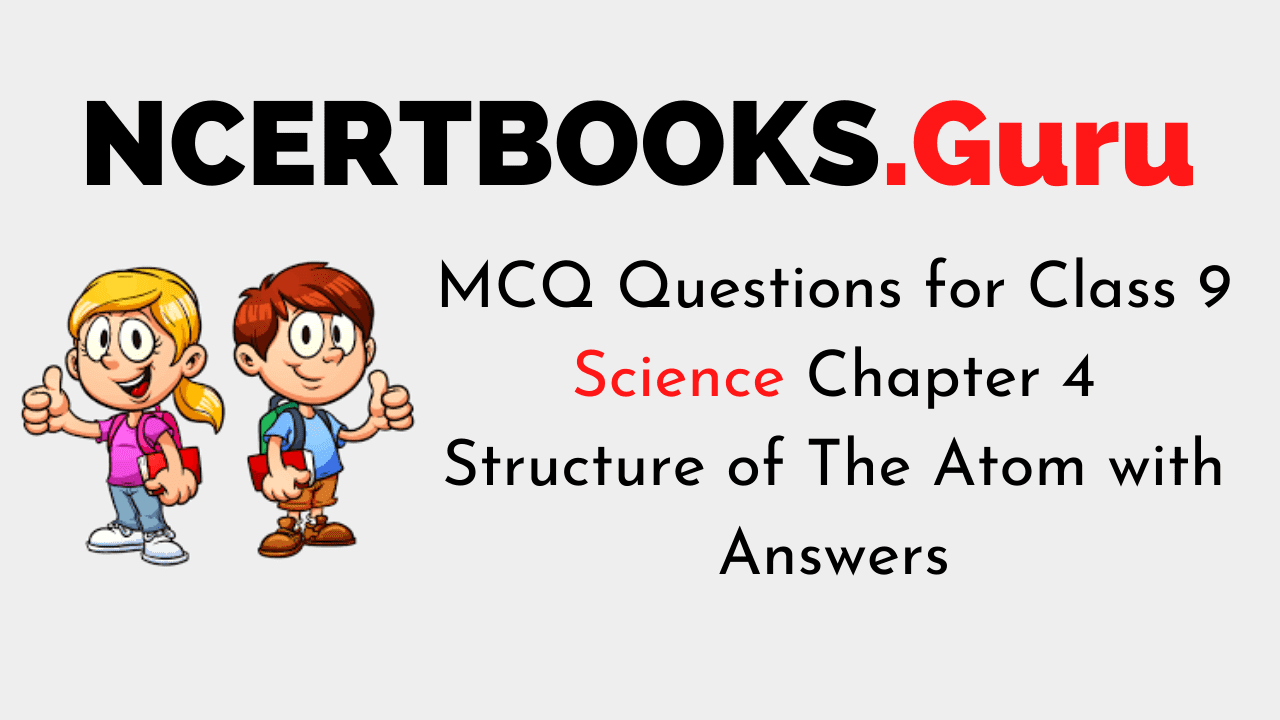MCQ Questions for Class 9 Science Chapter 4 Structure of The Atom with Answers
MCQs from Class 9 Science Chapter 4 – Structure of The Atom are provided here to help students prepare for their upcoming Science exam.
MCQs from CBSE Class 9 Science Chapter 4: Structure of The Atom
1. Who discovered the electron?
(a) Rutherford
(b) Chadwick
(c) Thomson
(d) Goldstein
Answer/ Explanation
(c) Thomson
2. Which isotope is used in the nuclear power plants to generate electricity?
(a) Uranium 235
(b) Iodine 131
(c) Cobalt 60
(d) Uranium 238
Answer/ Explanation
(a) Uranium 235
3. Why was the Thomson’s Model of an atom failed?
i. It could not explain the screening of negative charges from that of positive
ii. It did not tell about the presence of electrons
iii. It did not give an idea about the discrete energy levels
iv. It explained the atom as a whole to be electrically neutral
Choose the correct option from the following:
(a) Only (iii)
(b) Both (i) & (iii)
(c) Only (i)
(d) Both (ii) & (iv)
Answer/ Explanation
(b) Both (i) & (iii)
4. What was the source of alpha particles in Rutherford scattering experiment?
(a) Hydrogen nucleus
(b) Argon nucleus
(c) Helium nucleus
(d) None of these
Answer/ Explanation
(c) Helium nucleus
5. What property of an element determines its chemical behaviour?
(a) Size of an element
(b) Valency of an element
(c) Molar mass of the element
(d) None of these
Answer/ Explanation
(b) Valency of an element
6. Which of the following does not match the characteristics of an Isotope?
(a) Isotopes of some elements are radioactive
(b) Isotopes are the atoms of different elements
(c) Isotopes differ in number of neutrons
(d) Isotopes have similar chemical properties
Answer/ Explanation
(b) Isotopes are the atoms of different elements
7. Which of the two will be chemically more reactive, Sulphur(S) with atomic number 16 or Chlorine (Cl) with atomic number 17?
(a) Chlorine
(b) Sulphur
(c) Both are equally reactive
(d) Can’t say
Answer/ Explanation
(a) Chlorine
8. Which of the following elements does not exhibit the electrovalencey?
(a) Sodium
(b) Calcium
(c) Carbon
(d) Chlorine
Answer/ Explanation
(c) Carbon
9. Which of the following statements is incorrect about the structure of an atom?
i. The whole mass of an atom is concentrated in the nucleus
ii. The atom is an indivisible particle
iii. The atom as a whole is neutral
iv. All the atoms are stable in their basic state
Choose the right option among the following:
(a) (i) and (iii)
(b) only (ii)
(c) (ii) and (iv)
(d) none of these
Answer/ Explanation
(c) (ii) and (iv)
10. Which scientist gave the concept of fixed energy levels around the nucleus?
(a) Ernest Rutherford
(b) Neils Bohar
(c) J.J.Thomsan
(d) None of these
Answer/ Explanation
(b) Neils Bohar
11. What prevents an atom from being collapsed?
(a) The nuclear forces
(b) Movement of electrons in discrete energy levels
(c) The electron-electron repulsions
(d) All of these
Answer/ Explanation
(b) Movement of electrons in discrete energy levels
12. Which of the following pairs are isobars?
(a) 17Cl35 & 17Cl37
(b) 18Ar40 & 20Ca40
(c) 6C12 & 6C14
(d) None of these
Answer/ Explanation
(b)18Ar40 & 20Ca40
13. Which of the following is an incorrect statement in reference with observation in Rutherford’s α-particle scattering experiment?
(a) Some of the α-particles rebound after hitting the gold foil
(b) Some of the particles deflected from their path
(c) Some of the particles not pass through the gold foil
(d) Most of the particles pass straight through the gold foil
Answer/ Explanation
(a) Some of the α-particles rebound after hitting the gold foil
14. Which radioactive element is used in the treatment of cancer?
(a) Iodine-131
(b) Uranium-234
(c) Plutonium-239
(d) Cobalt-60
Answer/ Explanation
(d) Cobalt-60
15. Why do most of the elements try to participate in the chemical combinations?
i. To gain more electrons
ii. To achieve Inert Gas configuration
iii. To complete their octet
iv. To complete their inner shells
Choose the correct option among the following
(a) Both (i) & (iii)
(b) Both (ii) & (iii)
(c) Only (ii)
(d) Both (i) & (iv)
Answer/ Explanation
(b) Both (ii) & (iii)
